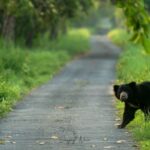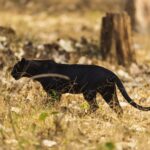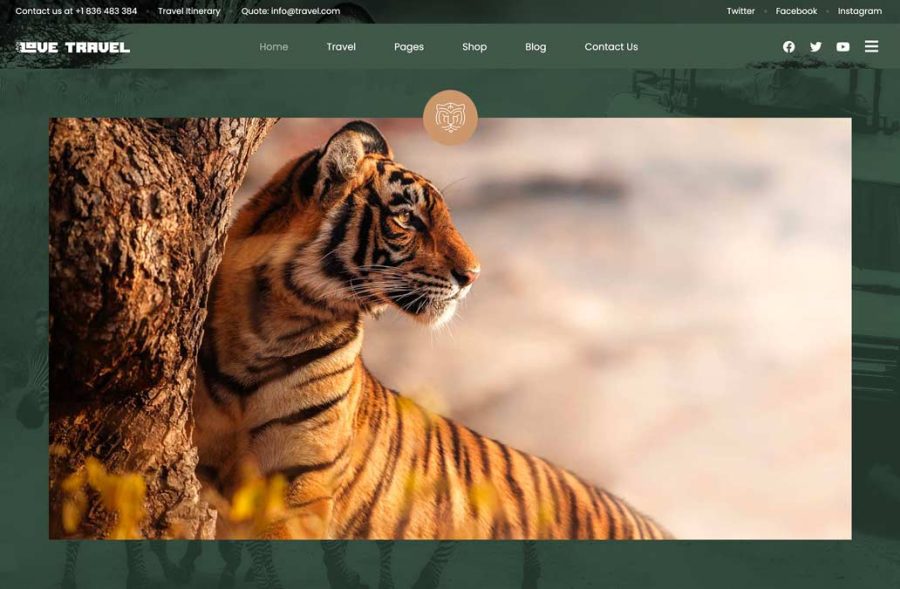Ah, the age-old safari dilemma: Tadoba core or buffer zone—which is better? The Core zone vs buffer zone question that echoes through jeep trails and forest rest houses across Maharashtra’s wild heart. Welcome to Tadoba Andhari Tiger Reserve, a place where the raw drama of the jungle unfolds daily—and if you’re lucky, you might just lock eyes with a tiger mid-prowl.
But before you even spot your first pugmark, you’re faced with a choice that could define your entire safari experience: Core Zone or Buffer Zone? It sounds simple, but the truth is far more nuanced. The Core is nature in its purest form, fiercely protected and largely untouched. The Buffer, on the other hand, is a fascinating dance between wilderness and humanity—a space where tigers roam and village life hums on the edge of the wild.
So, which is better? Well, like all things in nature… it depends. Let’s walk deeper into this forest of possibilities, shall we?
Key Takeaways: Core vs Buffer in Tadoba—What You Need to Know
- Understanding the distinction between Tadoba’s Core and Buffer Zones isn’t just helpful—it’s crucial. Each zone plays a unique role in the reserve’s conservation story.
- The Core Zone is strictly protected, designed for wildlife to thrive with minimal human interference. The Buffer Zone, meanwhile, is where nature and local communities coexist—a vital link in the chain of sustainable conservation.
- Ecotourism in Tadoba isn’t just about tiger-spotting. It’s part of a larger mission: supporting biodiversity, generating localemployment, and encouraging responsible travel across India’s wild landscapes.
- Timings and zones matter. Knowing where you’re going—and when—can make or break your safari. Planning ahead ensures you catch the jungle at its most alive.
- Each zone offers something different. The Core offers pristine wilderness and higher chances of big cat sightings. The Buffer? It’s a raw, real look at how wildlife and people live side by side.
- Want a seamless Tadoba safari? Book with an experienced wildlife tour operator. It’s the easiest way to navigate permits, choose the right zone, and avoid last-minute surprises in the jungle.
Discover the Enigmatic Tadoba Andhari Tiger Reserve
Tucked away in the dense teak forests of Maharashtra’s Chandrapur district, the Tadoba Andhari Tiger Reserve is a living, breathing symbol of India’s commitment to wildlife conservation. Covering a vast landscape of approximately 1,727 square kilometers, this reserve is not only one of the oldest in the country—established in 1955—but also among the most biologically rich and accessible.
The reserve is divided into two main zones: the Core Zones and the Buffer Zones.
The Core Zone spans around 626 square kilometers and represents the most protected and undisturbed habitat in the park. This is where nature operates on its own terms, with no villages, no permanent human activity, and minimal interference.
The Buffer Zone, on the other hand, surrounds the core and stretches over roughly 1,101 square kilometers. It plays a crucial role in bridging conservation and coexistence, allowing regulated human activity and tourism while supporting the livelihoods of local communities.
Tadoba currently boasts 6 official entry gates to the Core Zone.
These include Moharli, Kolara, Navegaon, Khutwanda, Zari, and Pangdi. Each gate offers access to a different terrain, and visitors often base their stay around a particular gate depending on wildlife movement patterns and accommodation availability.
In contrast, the Buffer Zone has seen tremendous growth in tourism infrastructure and now features 16 safari entry points, more than any other tiger reserve in India.
These gates are spread around villages that border the reserve, including places like Agarzari, Devada-Adegaon, Junona, Alizanza, Madnapur, Mamla, and the recently opened Somnath gate.
While the buffer may be seen as secondary, it’s increasingly gaining popularity for offering more affordable safaris, fewer crowds, and equally thrilling wildlife encounters—especially as tiger territories expand into these areas.
For wildlife enthusiasts, Tadoba is a dream come true. It is home to an estimated 115 individual tigers within the reserve boundaries and its surrounding landscape. Besides the tiger, Tadoba shelters Indian leopards, sloth bears, dholes (wild dogs), Indian gaurs, marsh crocodiles, and an impressive array of over 190 bird species and 74 butterfly varieties.
The flora here is dominated by dry deciduous forests with dense teak, bamboo thickets, and open grasslands. This mix of terrain, combined with perennial water sources like the Tadoba Lake, Kolsa Lake, and the Andhari River, provides ideal conditions for a thriving predator-prey ecosystem.
The Pristine Retreat: Exploring Tadoba Core Zones
Almost every call for Tadoba that we receive at Safari Lab, starts with the discussion about Core zones being better than buffer. That has a lot to do with the verbiage used to describe these areas.
‘Core’ sounds like you are venturing deep into the forest, whereas ‘buffer’ sounds like you are roaming in the exteriors. But that’s not entirely true. Here’s some information that you need to know.
All core zones of Tadoba offer access to the same protected forest, but from different gates, each with its own vibe, landscape, and legacy. Moharli, Kolara, Navegaon, and Khutwanda gates open into overlapping sections of the central Tadoba core, especially around the famous Pandharpauni and Teliya lake regions.
Similarly, Zari and Pangdi gates access the southern end of the park, a region once known as the Kolsa range. Though the forest is the same, your entry gate can shape your experience—how far you drive, what terrain you cover first, and sometimes even what wildlife you encounter.
Moharli Core Zone
Moharli is Tadoba’s oldest and most iconic gate, closest to Chandrapur city and rich in both history and hospitality. Safaris entering from Moharli often pass through the picturesque Teliya Lake—prime tiger country since the early 2000s.

This zone has been the stomping ground of Tadoba’s first celebrity tigers, including Maya, Sonam, Lara, and the formidable Wagdoh. Today, it remains one of the most productive zones, home to the likes of Chhoti Tara, Chhota Dadiyal, and the Mowgli male.
Thanks to the zone’s popularity, there’s a dense cluster of resorts nearby, making it a convenient base for first-time visitors.
Kolara Core Zone
Located closer to Chimur and thus more accessible from Nagpur, Kolara Core has quickly grown into a favorite for serious wildlife watchers.
This gate opens up into a strikingly diverse landscape—ranging from open meadows to thick bamboo and old teak plantations. Safaris here typically begin in the Pandharpauni region, a hotspot for big cat sightings.
Though Kolara shares its forest area with Navegaon, its unique mix of terrain and relative quietness compared to Moharli make it a standout for those seeking both drama and solitude in the jungle.
Navegaon Core Zone
Navegaon may share the same forest patch with Kolara, but it’s got a personality of its own. This gate is famous for the open meadows that attract herbivores—and by extension, big cats.
Its scenic routes and slightly off-the-main-path feel appeal to photographers and birdwatchers. Many safari-goers use Navegaon and Kolara interchangeably depending on permit availability, since the wildlife movement in this zone overlaps significantly between the two.
Khutwanda Core Zone
Khutwanda is essentially an alternative gateway into the Moharli landscape. In fact, vehicles from both gates often find themselves parked beside each other during tiger sightings, especially near waterholes and fire lines that cut across their shared territory.
Slightly quieter than Moharli, Khutwanda suits those who want the same tiger-rich forest but without the full tourist buzz of Moharli’s resort circuit.
Pangdi Core Zone
Pangdi sits on the southernmost fringe of Tadoba and is often described as a park within a park. This rugged, less-explored section is what old-timers still call Kolsa range. Pangdi’s terrain is more undulating, more remote, and carries with it the wild silence of true wilderness.
It’s a zone steeped in legacy—once ruled by the legendary Shivaji male, and still home to the resilient Hirdinala tigress, now around 14 years old and occasionally spotted near her old haunts. If you’re seeking an offbeat safari in tiger land, Pangdi delivers that raw, frontier feel.
Zari Core Zone
Zari shares the same forest area as Pangdi and offers similar landscapes, though it’s typically even quieter. The number of vehicles allowed here is deliberately kept low, preserving the integrity of the experience and the habitat.
Many naturalists describe Zari as one of Tadoba’s most pristine zones, where the forest feels undisturbed and sightings feel more intimate. It’s not as frequently booked as Moharli or Kolara, but for those willing to go the extra mile—literally—it offers a more secluded, soulful encounter with the wild.
The Wildlife-Rich, Best Buffer Zones of Tadoba
Tadoba Andhari Tiger Reserve now boasts 16 official buffer zone gates, forming a protective ring around its core forest. These buffer areas were originally established to reduce pressure on the core zone and to integrate local communities into conservation and ecotourism.
Today, many of these gates offer wildlife sightings that rival, and occasionally surpass, those in the core—especially as tigers adapt, establish territories, and raise cubs within these human-adjacent landscapes.
The Moharli buffer in particular is a thriving example of this transition. It consists of multiple gates, each offering unique terrain and a lineage of tigers who’ve made these fringe forests their kingdom.
Moharli Zone Buffer Gates
Let’s begin with the cluster of Devada–Junona–Adegaon and Agarzari, two adjoining regions with very different personalities—and plenty of tiger drama.
Devada–Junona–Adegaon Buffer Cluster
These three gates access a continuous patch of forest just outside the Moharli core zone. The terrain here is a mosaic of thick bamboo groves, interspersed with patches of grassland, seasonal nullahs, and wooded village fringes.
The buffer’s proximity to core water bodies means wildlife often spills over, especially during summer.
This zone is currently a tiger hotspot, home to Shambhu, a dominant male known for marking his territory confidently across this buffer spread. Among the females, Collarwali (not to be confused with Pench’s famous tigress) is raising cubs here, and W-mark, a tigress identified by the W-shaped mark on her forehead, is also nurturing a litter.
These resident tigers are the descendants of Moharli’s older generation—including Matkasur and Waghdoh—who were frequently pushed to buffer edges as younger males established dominance in the core.
The vibe here is rich and dynamic. You can witness everything from fresh pugmarks to cubs playing near water bodies, often without the tourist crowd typical of Moharli’s main zone.
Agarzari Buffer Gate
Just across the main road from the Devada–Junona–Adegaon cluster lies Agarzari. Though technically adjacent, this gate opens into a slightly different ecosystem—denser teak plantations, scattered marshes, and undulating terrain that’s quieter, darker, and known for sudden big cat surprises.
Agarzari has deep roots in Tadoba’s tiger history. It was the retirement home of Waghdoh, one of Tadoba’s most iconic and aggressive males, after he was ousted from the core by younger challengers.
During his reign here, Waghdoh sired multiple females—including Madhu, whose daughter Chhoti Madhu now dominates the zone.
Today, Chhoti Madhu and her cubs are frequently sighted here. Safaris through Agarzari offer a rare mix of lineage and solitude—you’re tracing the steps of a once-dominant dynasty while experiencing modern buffer dynamics at their most authentic.
Mamla Buffer Gate
At the southern fringe of Tadoba, where forest meets dry streambeds and bamboo shadows stretch long, lies Mamla—a lesser-known buffer with a wild heart. Though closest to Chandrapur city, it feels worlds away, offering terrain both rugged and raw, more reminiscent of Tadoba’s Kolsa region than Moharli’s busy trails.
Here, a story of survival quietly unfolds. Gauri, a vigilant tigress, raises three bold cubs amidst the dry gullies and teak thickets. Their prints crisscross the dust each morning, telling tales of play, practice, and predation.
Watching over them is Raka, a formidable male of immense size and power. His presence is unmistakable—bark scars on trees, scent marks in the wind, and silence that falls when he appears. In Mamla, he is both guardian and ruler.
This is a land shaped by the rhythm of the wild—less frequented, less tamed. And for those who enter it, Mamla offers a rare and stirring glimpse into the intimate lives of Tadoba’s tigers.
Kolara Zone Buffer Gates
To the north and east of Tadoba’s core, the Kolara buffer zone fans out through the rugged forests of the Chimur range.
This region, accessible primarily from Nagpur, features a diverse terrain of bamboo thickets, teak groves, grasslands, and small perennial waterholes—perfect habitat for big cats and their prey.
The buffer gates here are well-distributed and provide access to the same contiguous forest that hugs Kolara Core, often yielding excellent sightings without the bustle of high-traffic zones like Moharli.
With cooler canopy cover and multiple entry points, the Kolara buffer is increasingly becoming a favored choice for seasoned safari-goers looking to escape crowds and encounter wildlife in a more tranquil setting.
Among its gates, Madnapur, Sirkada, Palasgaon, Belara, and Alizanjha form a constellation of entryways into this wilderness—each offering its own micro-habitat and tiger story.
Madnapur Buffer Gate
Madnapur, also called Kolara Churadeo buffer, accesses the same forest block through a different gate. This region is an ecological blend of dense bamboo forests, grassy glades, and shallow seasonal water sources. The habitat here is cooler, quieter, and teeming with signs of tiger movement.
Dominating this landscape is Junabai, an old and respected matriarch of the Kolara landscape. As of June 2025, she’s raising two sub-adult cubs, steadily preparing them for independence. These cubs are sired by Xylo, a powerful and elusive male who has long roamed this zone. Recently, Junabai has also been observed mating with Nalya, another strong contender vying for territory, suggesting that her next chapter as a mother may soon unfold.
Veer male is another prominent figure here—often spotted patrolling the peripheries of Madnapur and occasionally clashing paths with Nalya. With multiple males in the mix, this buffer is alive with shifting dynamics, territorial challenges, and the slow, methodical rhythm of tiger life.
Madnapur stands out not just for its tiger density, but for the raw authenticity of its forest. Drives here are about more than just sightings—they’re about stepping into a living narrative that’s as much about survival as it is about serenity.
Sirkada Buffer Gate
In the drier months, when much of Tadoba wilts under the sun, Sirkada comes alive. Shaded by teak and bamboo, its scattered waterbodies become the stage for some of the park’s most dramatic encounters.
Here, Tigress Heena moves with quiet confidence, raising four cubs under her watchful eye. Not far off, Tigress T-209 tends to two young ones, guiding them between thickets and meadows.
Overhead, the ghost of the Dadiyal male still lingers—his territory now patrolled by Xylo, a dominant male in his prime.
Sirkada’s gift lies in its timing. In the swelter of summer, when water is scarce elsewhere, tigers converge here. And sometimes, in a single drive, you witness not one tiger—but a family, a lineage, a moment in the great rhythm of the wild.
Palasgaon Buffer Gate
Palasgaon stretches wide—open meadows, gently sloping fields, and sunlit forest clearings where the wind carries the scent of wild things. Once Tadoba’s designated night safari zone, it now rests under the calm of day, offering moments of quiet drama for those who know where to look.
Leopards patrol the fringes. Sloth bears emerge at dusk. Wild dogs slip through the grass in sudden bursts of movement. And from the neighboring ranges of Belara and Sirkada, tigers drift in—Bela with her cubs, Weera, the bold Xylo, and even Veer, whose territory brushes this zone’s edge.
What makes Palasgaon truly valuable is its availability. When other gates are booked out and permits scarce, Palasgaon is often the last-minute savior. A quiet corner of the forest, still full of life, waiting with open meadows and open chances.
Belara Buffer Gate
Belara lies in a quieter part of Tadoba’s mosaic, where narrow trails wind through dense bamboo and teak, and occasional clearings open onto hidden waterholes. Here, tigress Veera has become a local star—spotted with her two cubs during early safari drives in 2025, showcasing maternal focus and forest mastery.
Wildlife in Belara is diverse: from leopards slipping through underbrush to sloth bears rummaging in the shadows. “Bela” also roams this zone, overlapping with Veera’s territory at times—enhancing the chance of powerful tiger encounters.
Belara has gained recognition not just for its wildlife, but for its accessibility when other gates are fully booked. It often remains available, making it a reliable destination for last‑minute safari plans and top-tier wildlife viewing.
Core Zone vs Buffer Zone of Tadoba
Learning about the core zone vs buffer zone of Tadoba gives great insight. It shows how India’s wildlife sanctuaries work to protect animals. The Core Zones keep a natural home for many creatures. They are far from human activity to keep the environment as untouched as possible.
The Buffer Zones, on the other hand, let people and animals live near each other. Here, ecotourism helps the local people make money. At the same time, it safeguards wildlife by carefully managing how visitors interact with nature.
| Core Zone | Buffer Zone | |
|---|---|---|
| Entry Gates | 6 gates including Moharli and Khutwanda | 16 gates including Alizanza and Kolara Buffer Gate |
| Wildlife Sightings | High probability (115 tigers, 151 leopards) | Excellent. Rivalling and sometimes bettering core |
| Ticket Cost | 5k-12k per safari depending on booking date | 6K per safari |
| Conservation Focus | Strict protection, minimal human disturbance | Wildlife management, community engagement |
| Ecotourism Impact | Minimal, with controlled access | Enhanced opportunities, supports local economy |
Tadoba’s success comes from joining wildlife care and local involvement, especially in its Buffer Zones. This teamwork is good for the area’s economy.
It also teaches both locals and visitors why saving the environment is so important. This way, Tadoba becomes a top place in India for seeing nature and a variety of animals.
Ecotourism’s Vital Role in Tadoba Buffer Zones
In India, the Tadoba Andhari Tiger Reserve’s buffer zones shine as a key example of sustainable wildlife tourism. They are vital for many plants and animals, showing a winning formula for ecotourism in India. Covering 1130 square kilometers, they are home to a variety of life and the people who protect it.
Here, ecotourism means more than protecting the environment from harm. It’s about actively helping to save the tiger’s home. With the help of Eco-Development Committees (EDCs) and the Tadoba Conservation Foundation, 70% of tourism fees go back to local communities. This sharing of income has boosted the lives of people around, all thanks to sustainable wildlife tourism.
- Local planning and teamwork ensure that residents reap direct benefits from the tourists visiting their lands.
- Money from the Tadoba buffer zones supports not just economically but also helps in the better care of the land and its tigers.
- These areas welcome visitors all year round, even during the soggy monsoon, which helps keep local economies strong all through the year.
Thanks to ecotourism, locals no longer heavily rely on the forest for their needs. Programs like providing sewing machines to women have offered new, sustainable jobs outside of the forests. This shift is vital for both saving nature and giving people stable work.
Moreover, thanks to ecotourism, efforts to stop illegal activities and protect wildlife have grown. This strategy shows a balance between making money and protecting nature in a positive way. With more safari gates, more people can visit this beautiful area the right way.
Embarking on a Tadoba Safari: Tips for an Unforgettable Journey
Planning a Tadoba safari is thrilling, especially for tiger fans. The Indian wildlife sanctuaries at Tadoba are top-notch. Here are tips for a great journey.
- Advance Bookings: Make sure to book early, especially for summer. This is when tiger sightings are best. Slots fill up fast.
- Choose the Right Safari Zone: Tadoba has zones like Moharli, Kolara, and Navegaon. Each has special wildlife and scenery. Pick based on what you want to see.
- Stay Close to the Action: Find a lodge near the gates to save time. There’s a place for every budget near the safari gates.
- Follow Park Regulations: Be quiet, don’t litter, and stay on the safari trail. This helps keep the tigers’ home safe.
- Engage Local Guides: Local guides know a lot and boost your chance to see wildlife. They help the local area too.
Check out this table for more on Tadoba’s safari zones:
| Safari Zone | Gate Numbers | Number of Jeeps Allowed | Best Time for Tiger Spotting |
|---|---|---|---|
| Moharli | 7 gates | Summer (March to June) | |
| Kolara | 7 gates | Summer (March to June) | |
| Navegaon | 3 gates | Summer (March to June) | |
| Pangadi & Zari | 5 gates | Summer |
Each journey into the wild is special. With preparation and respect, your Tadoba safari will be incredible. You’ll see amazing tigers and the beauty of Indian wildlife sanctuaries.
Conclusion
We’ve explored the stunning landscapes of Tadoba National Park. The contrast between the Core Zone and Buffer Zone is clear. Each zone lets visitors experience amazing wildlife while supporting conservation efforts.
The Core Zones are carefully managed, perfect for seeing India’s tigers in their natural home. On the other hand, the Buffer Zones are as diverse and engaging. They also help communities close by with conservation actions.
The safaris at Tadoba show how we can protect nature while enjoying its beauty. Best for seeing tigers from March to June, the park also delights bird lovers. Tadoba highlights the importance of responsible tourism. This way, visitors help keep Tadoba beautiful for both people and animals.
Tadoba Andhari Tiger Reserve is a leader in caring for the environment and offering thrilling wildlife experiences. Walking through the buffers or exploring the core, Tadoba shows the heart of India’s wildlife. For those wanting to be part of Tadoba’s story, the park is open. This includes entrances like Moharli and Kolara. It welcomes everyone to enjoy pure nature’s theater.
FAQ
What distinguishes the Core Zone and Buffer Zone of Tadoba?
The Core Zone of Tadoba is the main area kept safe from heavy human contact. This is to protect the natural environment and the animals that live there. The Buffer Zone is an area around the Core. It lets people and wildlife interact more. It helps local communities earn a living through eco-friendly tourism. This Zone also supports the conservation effort.
Which zone in Tadoba is best for tiger spotting?
Tadoba offers excellent tiger sightings across both its core and buffer zones, with each area supporting its own resident tigers and unique terrain. Zones like Alizanjha, Sirkada, Agarzari, and Pangdi Aswal Chuha have gained strong reputations in recent years, thanks to frequent sightings of bold, territorial tigers such as Kaluwa, Heena, Chanda, K-mark, and the Ghagarzari female.
The buffer zones, once overlooked, now rival the core in both sighting frequency and diversity, often with fewer vehicles and a more peaceful safari experience. Core zones like Kolara, Navegaon, and Zari also remain reliable, especially in peak summer when tigers frequent waterholes.
Ultimately, there is no single “best” zone. Tiger movements are fluid, and sightings vary day by day. Choosing multiple zones over a few safaris—and keeping track of recent activity—offers the best chance of encountering Tadoba’s iconic big cats.
How are the local communities involved in Tadoba’s ecotourism initiatives?
Local people help run Tadoba’s eco-friendly tourism through EDCs. These committees work with the Tadoba Conservation Foundation. They help with tourism in a way that protects nature and helps the local economy.
What conservation efforts are in place at Tadoba to protect tigers?
The Tadoba Tiger Reserve has many plans to protect tigers. They work hard against illegal hunting. They also take care of their living spaces. They use tourism to watch over tigers. Local people are also involved. They keep a check on the reserve and help protect tigers.
Can tourists visit both the Core and Buffer Zones of Tadoba?
Yes, you can see both the Core and Buffer Zones of Tadoba. Each area shows you different nature and animals. You must enter from specific gates. Especially for Core Zones, it’s good to book your visit early because they limit the number of visitors.
What is the ideal time to visit Tadoba for the best wildlife experience?
The best time to see Tadoba’s wildlife, especially tigers, is from March to May. This period is just before the rain starts. The hot weather makes animals come out more, making it easier for you to see them.
Are there any guidelines tourists should follow while on a Tadoba safari?
Yes, there are rules you need to follow for a good wildlife experience. This includes not making loud noises, not dropping litter, not feeding the animals, staying on the safari path, and obeying all safety advice. Local guides and authorities will also tell you how to behave.
What wildlife besides tigers can be seen in Tadoba?
Other than tigers, you can find many animals at Tadoba. This includes leopards, sloth bears, Indian bisons, deer, wild dogs, and lots of birds. Tadoba’s different areas support a big variety of life, making it a great place to see India’s wildlife up close.
Is it possible to stay overnight in the Tadoba Andhari Tiger Reserve?
Yes, there are many places to stay in Tadoba overnight. This includes forest lodges, resorts, and homestays. They fit different budgets and needs, all letting you have a special time surrounded by nature.


























